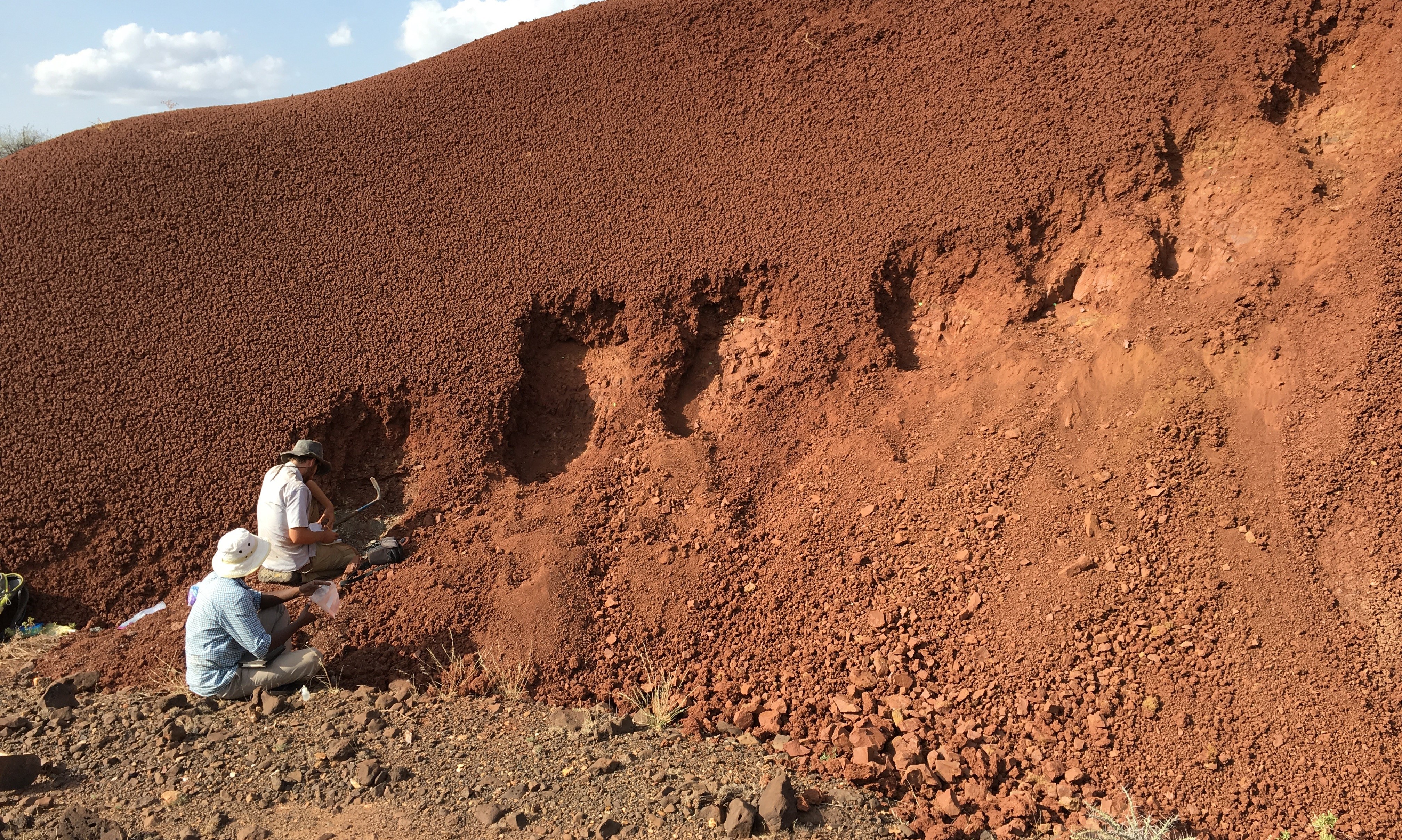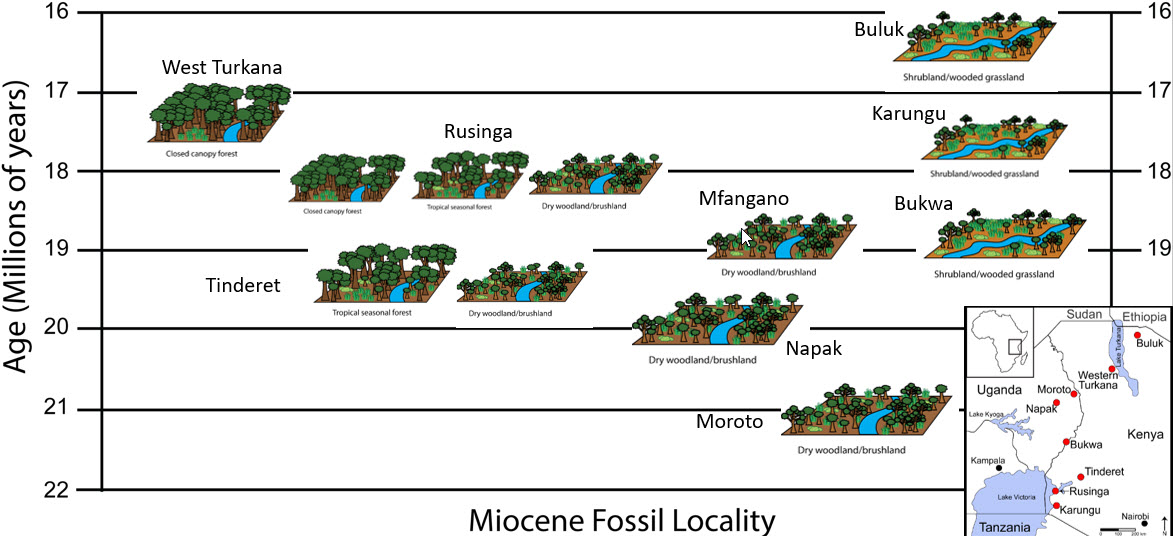Decade-long Research by Baylor Geoscientist, Researchers Pushes Back Africa’s Prehistoric Timeline by Over 10 Million Years
Dan Peppe, Ph.D., associate professor of geosciences at Baylor University
Contact: Kelly Craine, Baylor University Media and Public Relations, 254-297-9065
Follow us on Twitter: @BaylorUMedia
WACO, Texas (April 13, 2023) – Something as simple as a grass can fundamentally change the understanding of life in the prehistoric world. A pair of studies funded by the National Science Foundation and published in the journal Science document the earliest evidence for locally abundant C4 grasses in eastern Africa and how C4 grasses and open habitats influenced early ape evolution.
Since 2013, Daniel Peppe, Ph.D., associate professor of geosciences at Baylor University and an international team of researchers have focused their research on understanding how ancient environments influenced the evolution of early apes in eastern Africa.
Researchers have often argued that during the early Miocene, between about 15 and 20 million years ago, equatorial Africa was covered by a semi-continuous forest and that open habitats with C4 grasses didn't proliferate until about 8 to 10 million years ago. Yet there was some research that showed contradictory evidence to this long held idea. This lone study had evidence of C4 grasses in East Africa around 15 million years ago. Peppe and the research team set out to find if this study was an anomaly or a clue to the true diversity of ecosystems that occurred during the early Miocene.
Determining if open habitats and C4 plants were more prevalent much earlier than originally thought would have important implications for understanding the features and adaptations of early apes and why there are tropical C4 grasslands and savanna ecosystems in Africa and around the world.
Peppe and a collaborative team of geologists conducted research alongside of paleoanthropologists at nine Early Miocene fossil site complexes in the East African Rift of Kenya and Uganda.
Collectively known as the Research on Eastern African Catarrhine and Hominoid Evolution project or REACHE, the team simultaneously focused on understanding the types of ecosystems that existed in the early Miocene, and particularly the prevalence of open environments and C4 grasses, and how these different environments could have potentially affected the evolution of early apes, such as Morotopithecus.
The research flourished through the uniqueness of the REACHE project, according to co-author, Kieran McNulty, Ph.D., professor of anthropology at the University of Minnesota who played a central role in organizing the project.
“Working in the fossil record is challenging. We discover hints and clues about past life and need to figure out how to assemble and interpret them across space and time. Any one of the analyses in these papers would have made for an interesting study, and any one of them, alone, would have produced incomplete, inconclusive or incorrect interpretations,” McNulty said. “That is the nature of paleontological research: it’s like putting together a 4D puzzle, but where each team member can only see some of the pieces. By combining these methods, we leverage the strength of one to shore up weaknesses or validate assumptions of another, resulting in a synthetic approach that challenge well-established theories.”
As participants exchanged information and expertise about geological features, isotopes and plant and ape fossils found at the sites, the bigger picture came into focus. The paradigm that during the early Miocene period equatorial Africa was completely forested was wrong.
Further, the result of this decade long research pushes back the oldest evidence of C4 grass-dominated habitats in Africa – and globally – by more than 10 million years, calling for revised paleoecological interpretations of the development of plants and mammals.
“We suspected that we would find C4 plants at some sites, but we didn't expect to find them at as many sites as we did, and in such high abundance, “Peppe said. “Multiple lines of evidence show that C4 grasses and open habitats were important parts of the early Miocene landscape and that early apes lived in a wide variety of habitats, ranging from closed canopy forests to open habitats like scrublands and wooded grasslands with C4 grasses. It really changes our understanding of what ecosystems looked like when the modern African plant and animal community was evolving.”
A critical aspect of this work was that the team combined many different lines of evidence together: geology, fossil soils, isotopes and phytoliths, which are plant silica microfossils, to reach their conclusions.
“The history of grassland ecosystem in Africa prior to 10 million years had remained a mystery, in part because there were so few plant fossils, so it was exciting when it became clear that we had phytolith assemblages to add to the other lines of evidence,” said co-author Caroline Strömberg, Ph.D., professor of biology at the University of Washington. “Phytoliths are particularly informative for revealing the history of grassland ecosystems. They can tell us not just that there were grasses, but which grasses were there and how abundant they were on the landscape. What we found was thrilling, and very different from what was the accepted story. We used to think tropical, C4 dominated grasslands only appeared in the last 8 million years or so, depending on the continent. Instead, both phytolith data and isotopic data showed that C4 dominated grassy environments appeared over 10 million years earlier, in the early Miocene in eastern Africa.”
This much earlier occurrence of C4 grasses and open habitats found at the same sites as early apes also allowed the researchers to assess the kinds of environments in which the early apes were living, according to co-author Rahab Kinyanjui Ph.D. of the National Museums of Kenya and Max Planck Institute.
“As a paleobotanist, my first task in any fieldwork is to undertake vegetation study of the site in question. Then I collect sediments with known geological age, either absolute or relative dates,” Kinyanjui said. “My work gets exciting once I process and extract plant microfossils in the lab to study them through the microscope. This task can take weeks to months depending on the number of samples, abundance and diversity of the plant’s microfossils. These are weeks/months spent in the ancient wilderness, habitats that are no longer in existence. Roaming through ecosystems imagining the kind of animals you are likely to encounter in the forests, bushlands and grasslands.”
Importantly, one of the most advanced early apes, Morotopithecus, was found to inhabit open woodland environments with abundant grasses and to rely on leaves as an important component of its diet. This contradicts long-standing predictions that the unique features of apes, such as an upright torso, originated in forested environments to enable access to fruit resources. These findings are transformative, said Robin Bernstein, program director for biological anthropology at the U.S. National Science Foundation.
“For the first time, by combining diverse lines of evidence, this collaborative research team tied specific aspects of early ape anatomy to nuanced environmental changes in their habitat in eastern Africa, now revealed as more open and less forested than previously thought. The effort outlines a new framework for future studies regarding ape evolutionary origins,” Bernstein said.
ABOUT THE AUTHORS
In addition to Daniel J. Peppe, the research team includes Susanne M. Cote, Alan L. Deino, David L. Fox, John D. Kingston, Rahab N. Kinyanjui, William E. Lukens, Laura M. MacLatchy, Alice Novello, Caroline A.E. Strömberg, Steven G. Driese, Nicole D. Garrett, Kayla R. Hillis, Bonnie F. Jacobs, Kirsten E.H. Jenkins, Robert Kityo, Thomas Lehmann, Fredrick K. Manthi, Emma N. Mbua, Lauren A. Michel, Ellen R. Miller, Amon A.T. Mugume, Samuel N. Muteti, Isaiah O. Nengo, Kennedy O. Oginga, Samuel R. Phelps, Pratigya Polissar, James B. Rossie, Nancy J. Stevens, Kevin T. Uno and Kieran P. McNulty.
This work was funded by the National Science Foundation grants BCS 1241812, BCS 1241817, BCS 1241918, EAR 1253713, EAR 1053549, BCS 1638796 and DGE 16-44869.
ABOUT BAYLOR UNIVERSITY
Baylor University is a private Christian University and a nationally ranked Research 1 institution. The University provides a vibrant campus community for more than 20,000 students by blending interdisciplinary research with an international reputation for educational excellence and a faculty commitment to teaching and scholarship. Chartered in 1845 by the Republic of Texas through the efforts of Baptist pioneers, Baylor is the oldest continually operating University in Texas. Located in Waco, Baylor welcomes students from all 50 states and more than 100 countries to study a broad range of degrees among its 12 nationally recognized academic divisions.
ABOUT THE COLLEGE OF ARTS & SCIENCES AT BAYLOR UNIVERSITY
The College of Arts & Sciences is Baylor University’s largest academic division, consisting of 25 academic departments in the sciences, humanities, fine arts and social sciences, as well as 11 academic centers and institutes. The more than 5,000 courses taught in the College span topics from art and theatre to religion, philosophy, sociology and the natural sciences. The College’s undergraduate Unified Core Curriculum, which routinely receives top grades in national assessments, emphasizes a liberal education characterized by critical thinking, communication, civic engagement and Christian commitment. Arts & Sciences faculty conduct research around the world, and research on the undergraduate and graduate level is prevalent throughout all disciplines. Visit the College of Arts & Sciences website.

